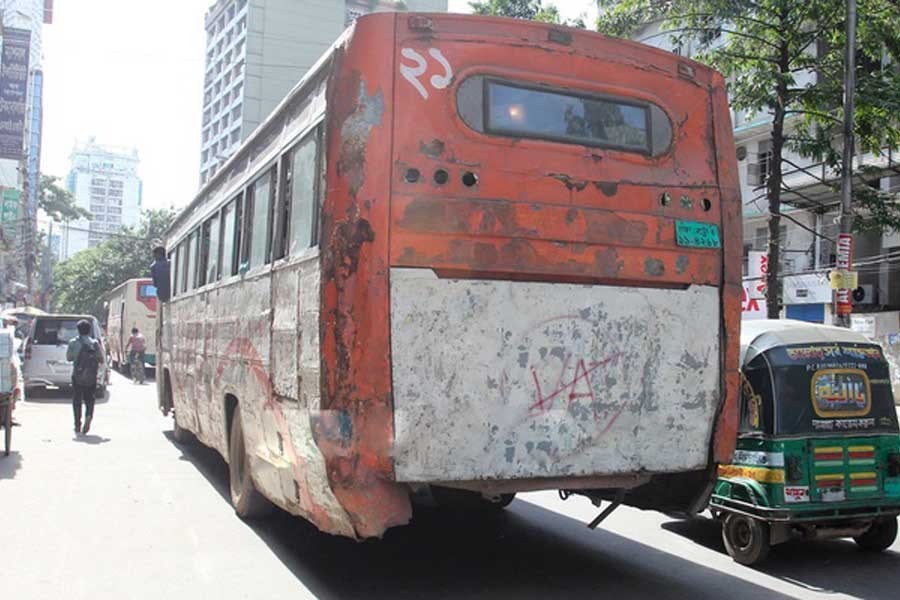A hideous and rundown vehicle squeaking along a highway or a city road spewing out black smoke is a common sight in this country. They are makeshift careers. Despite repeated warnings against the plying of these automobiles in the busy streets, the urban and semi-urban areas throughout the country have become accustomed to watching these dilapidated automobiles. Thanks to their making in the hands of novice and half-skilled mechanics, they are a loose iron frame with a platform for sitting and carrying loads. They remain vulnerable as long as they are on the road. These makeshift vehicles are highly accident-prone, pose hazards to other vehicles, and are a dread to the common passengers and drivers. The operators of these so-called automobiles mostly rent them out to petty businesses for carrying their merchandise on short distances. On occasions these vehicles give short-haul rides to the farm hands.
In another view, vehicles ride along the streets of Dhaka and other cities after undergoing a transformation. Originally baby-taxis or CNGs, they are remodelled into a hybrid auto-rickshaw called the easy-bike. For their low fare, passengers find them economical. The transport is banned in the city areas. But they are pervasively present in Dhaka's inner roads. Upon seeing them in numbers in the alleys branching out from the bigger roads, many feel scared. It's because small accidents with passengers on board are a common occurrence with these ultra-light vehicles. The outer look of the easy-bikes is not revolting, as raw and gaudy figurative paintings cover their whole body.
However, a sense of acute depression overtakes passengers and passersby while they are on the road. It stems from the shabby and, at times, wretched-looking buses. Following an all-out operation against these dilapidated buses plying the Dhaka streets, their numbers witness a radical cut. After the police actions they remain off the streets for some time, and come back. They appear to have tolerable coats of paint and some repair works. Finally, they return to the Dhaka roads in a couple of months with almost the same old look. Except for some preliminary brush-ups, the buses --- battered, noisy and smoke emitting, stage a full comeback finally with their earlier dominance.
Normally, an order of the DMP is in place which directs the operators to keep their vehicles spruced up, and free of all kinds of dents. These directives often fall on deaf ears. A local bus with its backside almost gone, and showing its entire inside was once a common view on the main Dhaka streets. Nothing in the busy roads could be more atrocious. The said bus and some others like it became a common spectacle to the Dhaka commuters. In the developed and many developing countries, the authorities regularly check on the vehicles' outer look. Unsightly buses, private cars, taxis, trams, pick-up vans etc aren't allowed to ply the streets. People themselves are aware of the police actions against the vehicles if they are found rusty, peeled off or emitting noise. Apart from looking into fitness certificates, driving licences and other papers on suspicion, the traffic police authorities are also empowered to see if a vehicle is road worthy in terms of the outer look. In Bangladesh the outer views of few cars are checked. This prerequisite is normally overlooked unless a vehicle becomes inoperative.
The beauty of an urban centre, be it a large or a small one, comprises a lot of things. Those include the apartments, office buildings, the transport network, and also the passers-by. Of them, the buildings and the moving vehicles occupy two major spots. On both the counts, Bangladesh lags behind many poorer countries. At least these countries do not have to deal with vehicles making deafening sounds or emitting billows of black smoke. Thus civilised driving and the condition of vehicles have to be entwined with the lofty dream of a country. In order to achieve a certain status, the apparently minor issues weigh in to decide a country's fate. The traffic situation, coupled with the running vehicles' look, ought not to be overlooked.
In the distant past, those who owned a car would be viewed with respect and certain awe. Thanks to its formidably high price, a car would be regarded as an exclusive possession. People who owned a car would take extra care of their vehicles. The persons driving the car, after a long service, would pour his love into the inanimate object. This phenomenon could be found in all drivers serving both government and non-government offices. In fact, drivers have to love their vehicles. Even if their employers tread a wrong path regarding the cars' operation, they can come up and correct them. Those days are gone. Nowadays, anybody can own a car. Second-hand vehicles rule the roost on the informal car markets. Picking a car from such a market or from a long- known acquaintance is generally risk-free. But when the car starts giving trouble and at one time stops taking start, the owner frantically looks for a gullible buyer.
In the complicated task of selling a car off, a section of broker-drivers play the dominant role. Eventually, they bring many innocent lower middle-class car-owners into the lucrative clandestine market of car trade. A sizable number of them are later sucked into the dark alleys of the market of ersatz cars.


